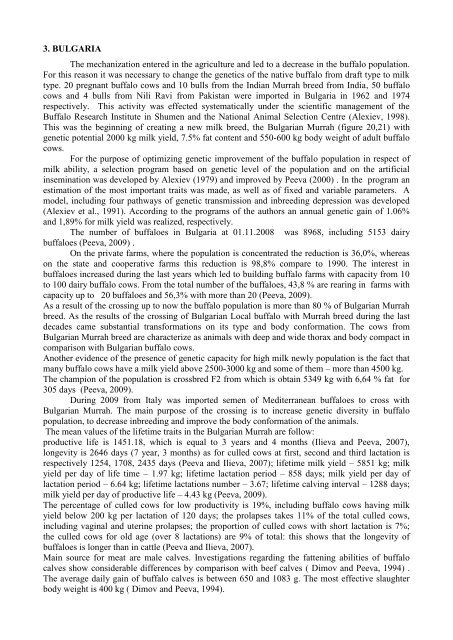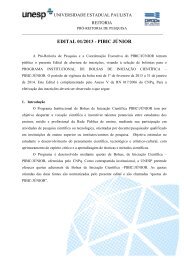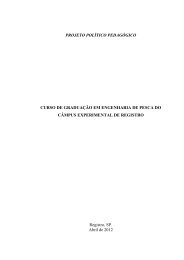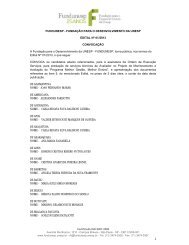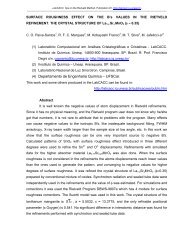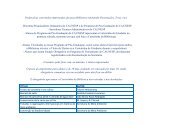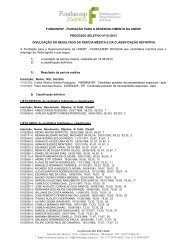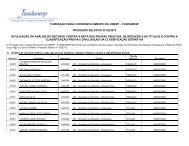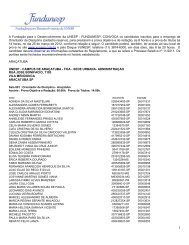Untitled - Faculdade de Medicina Veterinária e Zootecnia - Unesp
Untitled - Faculdade de Medicina Veterinária e Zootecnia - Unesp
Untitled - Faculdade de Medicina Veterinária e Zootecnia - Unesp
You also want an ePaper? Increase the reach of your titles
YUMPU automatically turns print PDFs into web optimized ePapers that Google loves.
3. BULGARIA<br />
The mechanization entered in the agriculture and led to a <strong>de</strong>crease in the buffalo population.<br />
For this reason it was necessary to change the genetics of the native buffalo from draft type to milk<br />
type. 20 pregnant buffalo cows and 10 bulls from the Indian Murrah breed from India, 50 buffalo<br />
cows and 4 bulls from Nili Ravi from Pakistan were imported in Bulgaria in 1962 and 1974<br />
respectively. This activity was effected systematically un<strong>de</strong>r the scientific management of the<br />
Buffalo Research Institute in Shumen and the National Animal Selection Centre (Alexiev, 1998).<br />
This was the beginning of creating a new milk breed, the Bulgarian Murrah (figure 20,21) with<br />
genetic potential 2000 kg milk yield, 7.5% fat content and 550-600 kg body weight of adult buffalo<br />
cows.<br />
For the purpose of optimizing genetic improvement of the buffalo population in respect of<br />
milk ability, a selection program based on genetic level of the population and on the artificial<br />
insemination was <strong>de</strong>veloped by Alexiev (1979) and improved by Peeva (2000) . In the program an<br />
estimation of the most important traits was ma<strong>de</strong>, as well as of fixed and variable parameters. A<br />
mo<strong>de</strong>l, including four pathways of genetic transmission and inbreeding <strong>de</strong>pression was <strong>de</strong>veloped<br />
(Alexiev et al., 1991). According to the programs of the authors an annual genetic gain of 1.06%<br />
and 1,89% for milk yield was realized, respectively.<br />
The number of buffaloes in Bulgaria at 01.11.2008 was 8968, including 5153 dairy<br />
buffaloes (Peeva, 2009) .<br />
On the private farms, where the population is concentrated the reduction is 36,0%, whereas<br />
on the state and cooperative farms this reduction is 98,8% compare to 1990. The interest in<br />
buffaloes increased during the last years which led to building buffalo farms with capacity from 10<br />
to 100 dairy buffalo cows. From the total number of the buffaloes, 43,8 % are rearing in farms with<br />
capacity up to 20 buffaloes and 56,3% with more than 20 (Peeva, 2009).<br />
As a result of the crossing up to now the buffalo population is more than 80 % of Bulgarian Murrah<br />
breed. As the results of the crossing of Bulgarian Local buffalo with Murrah breed during the last<br />
<strong>de</strong>ca<strong>de</strong>s came substantial transformations on its type and body conformation. The cows from<br />
Bulgarian Murrah breed are characterize as animals with <strong>de</strong>ep and wi<strong>de</strong> thorax and body compact in<br />
comparison with Bulgarian buffalo cows.<br />
Another evi<strong>de</strong>nce of the presence of genetic capacity for high milk newly population is the fact that<br />
many buffalo cows have a milk yield above 2500-3000 kg and some of them – more than 4500 kg.<br />
The champion of the population is crossbred F2 from which is obtain 5349 kg with 6,64 % fat for<br />
305 days (Peeva, 2009).<br />
During 2009 from Italy was imported semen of Mediterranean buffaloes to cross with<br />
Bulgarian Murrah. The main purpose of the crossing is to increase genetic diversity in buffalo<br />
population, to <strong>de</strong>crease inbreeding and improve the body conformation of the animals.<br />
The mean values of the lifetime traits in the Bulgarian Murrah are follow:<br />
productive life is 1451.18, which is equal to 3 years and 4 months (Ilieva and Peeva, 2007),<br />
longevity is 2646 days (7 year, 3 months) as for culled cows at first, second and third lactation is<br />
respectively 1254, 1708, 2435 days (Peeva and Ilieva, 2007); lifetime milk yield – 5851 kg; milk<br />
yield per day of life time – 1.97 kg; lifetime lactation period – 858 days; milk yield per day of<br />
lactation period – 6.64 kg; lifetime lactations number – 3.67; lifetime calving interval – 1288 days;<br />
milk yield per day of productive life – 4.43 kg (Peeva, 2009).<br />
The percentage of culled cows for low productivity is 19%, including buffalo cows having milk<br />
yield below 200 kg per lactation of 120 days; the prolapses takes 11% of the total culled cows,<br />
including vaginal and uterine prolapses; the proportion of culled cows with short lactation is 7%;<br />
the culled cows for old age (over 8 lactations) are 9% of total: this shows that the longevity of<br />
buffaloes is longer than in cattle (Peeva and Ilieva, 2007).<br />
Main source for meat are male calves. Investigations regarding the fattening abilities of buffalo<br />
calves show consi<strong>de</strong>rable differences by comparison with beef calves ( Dimov and Peeva, 1994) .<br />
The average daily gain of buffalo calves is between 650 and 1083 g. The most effective slaughter<br />
body weight is 400 kg ( Dimov and Peeva, 1994).


